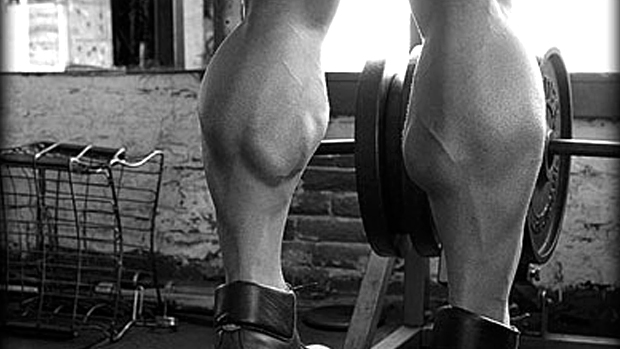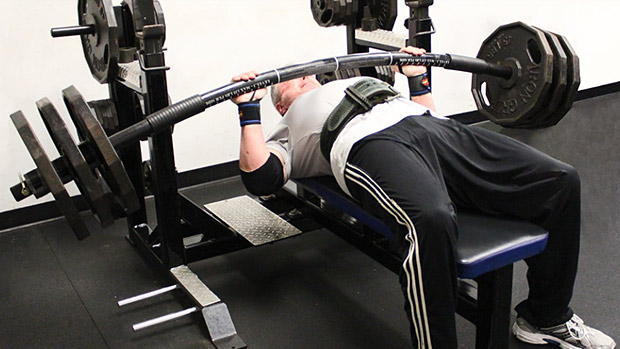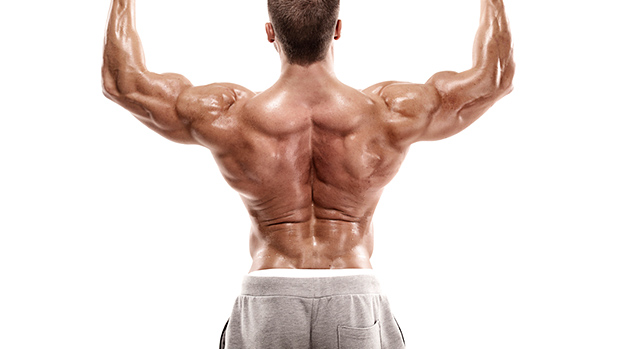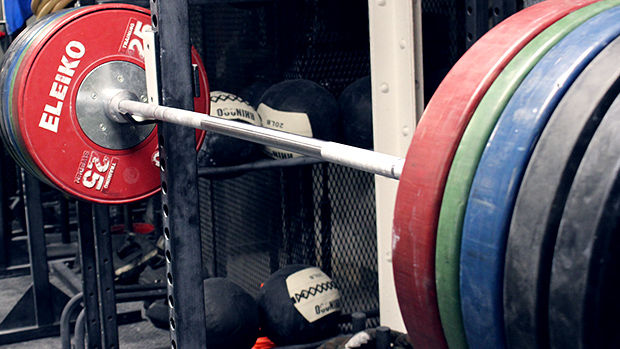Most people point to the shoulders, chest, and biceps as being the "manly" muscles. But if you ask me, a big, strong set of calves is the winner. I'm not alone with this sentiment either. Just look at the Greek and Roman statues from thousands of years ago.
Rodin's famous sculpture, "The Thinker," has huge calves; so does Myron's "The Discus Thrower." Hell, even Brad Pitt had to slap some healthy mass on his calves for his role as Achilles in the visually stunning, albeit humdrum, Troy.
There's no doubt that proportionally large calves exude masculinity. In fact, the mere presence of huge calves brings to mind "power." Have you ever seen a gargantuan bodybuilder with small calves? I'm sure you have. The words that come to mind when I see this combination are "weakness" and "imbalance."
This all makes sense, if you think about it. Thousands of years ago, if you were born weak and skinny, you were pretty much left floating on Shit Creek sans paddle. In 800 BC, the idea of calf training was akin to finding a Starbucks next to the Roman Coliseum. On the other hand, the mesomorphic types from ancient times who, instinctively, would've made better warriors and were likely born with big calves, were put on a pedestal. Literally.
Let's fast forward to modern times.
These days, we have a pretty damn good idea how to make muscles bigger. You must train with a variety of loads, incorporate plenty of intensity and volume, and feed your body with nutrients to support growth and recovery.
But, when it comes to one of the most stubborn muscle groups known to man, it takes a lot of planning, dedication, and drive to turn those calves into cows.
The Puny Calf Syndrome
Why do so many people have such proportionally small calves? There's no doubt that genes play a role. I'll postulate that no one ever gave calf training any thought until bodybuilding contests became en vogue. Since we're talking about a mere fifty years, that doesn't give our sluggish genes much time to upregulate protein synthesis during development.
If all of our ancestors had been training their calves with hypertrophy methods, we probably wouldn't be in such a pickle. Put another way, we wouldn't have calves the size of pickles.
Another reason is because we typically don't devote enough time and energy to building bigger calves. If you want a muscle to grow, you've got to really focus your efforts on it. Calf training can be, well, kind of mind-numbing, so I'm not surprised that hordes of lifters look like they're riding on an ostrich.
A third reason why puny calf syndrome is so prevalent is because lifters assume that what works for, say, the chest must work for the calves. If it were that simple, we'd all be sportin' massive diamonds above our Nikes.
Choose the Right Parents
Some of us never have to worry about calf training. That's because their ancestors passed down enough mesomorphic genes to negate the need. Makes you kind of nauseous, doesn't it? Based on my natural calf development, I'd surmise that no one in my family tree spent any time on their feet.
But, fret no more. If there's one thing I know, it's how to build bigger muscles. Through much trial and error, I've managed to add three inches of girth to my calves over the years. Fortunately, you won't have to wait nearly that long because I've made many, many mistakes along the way. The list is extensive, but these are a few of my blunders from the early days:
Annihilation
When I was 21, there was a three-week period where I trained my calves once each week. Each session was comprised of twenty sets of standing calf raises with mind-blowing intensity. I couldn't walk straight for the first week. Moreover, my calves were so damn sore that the mere friction from my jeans against my gastroc caused pain. No joke.
My calves shrunk a quarter of an inch by the end of that phase because I was fatiguing the wrong motor unit pool. Not to mention, I bombarded them without building up my calves' tolerance to high volume training.
Strike one.
Heavy Standing Calf Machine Raises
I like to train heavy, that's for sure. But, a typical standing calf raise machine with pads that press down on your shoulders is a pretty shitty exercise. This is especially true when the load is very heavy. I've found this exercise to be good for two things: stretching your upper traps and making you shorter. I think I lost about half an inch of height during that three-week phase. That's no joke either.
Strike two.
Neglecting Recovery Weeks
Once I finally got around to understanding the importance of training the calves with a high frequency, I didn't respect the importance of unloading (recovery) weeks. Our calves are constantly under tension throughout the day. If you annihilate your calves, you must give them some extra time to recover every third or fourth week. That is, unless you relish the thought of chronic plantar faciitis.
Strike three.
High Frequency is the Modern Achilles
Were I a sculptor, my modern day sculpture would have huge calves, too. I'd call my masterpiece, "Do High Frequency Training or Invest in Long Pants."
To make your calves grow as fast as possible, you need to start working them as often as possible. Nothing is better for calf development than tripling, or even quadrupling, your frequency. There's much more, however, that you need to understand.
1. Build up your frequency
Your progress plan will be based solely on frequency because it's the most effective for calf growth. Athletes who compete in sports that require high levels of calf activation (soccer, sand volleyball, floor gymnastics, cycling, etc) have proportionally large calves. Furthermore, these athletes are training their calves almost daily with their sport.
2. Train your entire calf region
This is where almost all lifters and coaches fall short. If you want bigger arms you don't just train your triceps, right? Well, if you do nothing but calf raises that's essentially what's happening; you're only stimulating half of your calf region. It's imperative that you train the muscles on the front of your calves. This trick alone has helped many of my clients break through plateaus.
3. Focus on recruiting the highest threshold motor units that have the most growth potential
The calves, by and large, are endurance muscles, but that doesn't mean you should train them for moreendurance. The principles for recruiting your largest motor units don't change based on a muscle's fiber make-up. You need to train heavy, and you need to perform each contraction as fast as possible.
Endurance training can make your muscle fibers smaller in order to allow more transfer of nutrients (the thinner a fiber, the better it is at receiving nutrients). This is why marathon runners have skinny thighs.
4. Cut back on direct calf training every three to four weeks
With this program, you'll be constantly increasing your frequency. In essence, you'll force your muscles to work before they're fully recovered. This is a strong stimulus for hypertrophy, but you must give the calves room to grow once or twice each month by decreasing the frequency.
5. Get some soft tissue work
I can't count how many clients I've worked with who've benefited by fascial work. This is especially true with the calves. Years of training and poor posture often lead to stiff fascia that can, possibly, impair muscle growth. Also, scar tissue can develop around your soft tissue that limits the nutrient transfer that's necessary for recovery. Find a reputable deep tissue massage therapist or Active Release Techniques® (ART®) practitioner in your area.
6. Develop the mind-muscle link
We're all competent when it comes to squeezing our biceps for an intense contraction. Many of us, however, have a very weak mind-muscle link with our calves. Whether it's due to the distance between your brain and calves, or the fact that you haven't really focused on training with intense contractions, or a combination of the two doesn't matter.
What matters is that you develop the link between them. By doing so, you'll recruit more motor units. This is a very important topic, and a key to building bigger calves, so I'm going to go beyond the quick and dirty version.
How do you develop the mind-muscle link with your calves? The simplest way is to place your fingertips on your calf muscles and perform ten contractions. Ideally, you'd do this in the gym, but it's not practical with many exercises. Therefore, I recommend you do it at home, or in the office, two to three times each day.
Here's how it works:
Gastrocnemius
Stand on your left foot. Shift your torso forward and support yourself with your right hand on a chair or bench. Place the fingertips of your left hand on your left gastroc (the biggest portion of your calf muscles). Perform ten calf raises while bent over with your fingers on your left gastroc.
You should feel around for areas that don't seem to be developing as much tension and keep your fingers on them. For many, the medial or lateral portion contracts more than the other. You need to make all of your gastroc fibers develop as much tension as possible.
For me, the lateral portion needed the most work (it felt softer than the medial region during a calf raise). For you, it might be the opposite. Focus on developing as much tension as possible and really concentrate on how your calves feel when they're contracting. Repeat with the opposite leg.
Soleus
Sit in a chair or on a flat bench with your knees bent and feet flat. Place your left fingertips on the lower portion of your left calf (soleus). Perform ten seated calf raises and really focus on achieving an intense contraction, getting it to cramp, if possible. Repeat with the opposite leg.
Anterior Tibialis
Sit on a chair or flat bench with your knees bent and feet flat. Place your left fingertips on the lateral portion of the anterior portion of your left calf. Your left knee shouldn't be at 90 degrees; it should be closer to 130 degrees (extended) to allow for a greater range of motion.
With your left foot on the floor, and your left leg slightly extended, pull your left foot up (dorsiflex) while keeping your left fingertips on the lateral portion of your anterior calf. Perform ten reps and focus on an intense contraction. Repeat with the opposite leg.
Focus on doing these straightforward exercises two to three times each day. If you do, you'll get a lot more out of your calf training because your mind-muscle link will be much stronger.
This is the simplest way to build the mind-muscle link, but an even more effective way is to have your trainer or partner do the touching (insert your favorite joke here). For more information, pick up a copy of Rothenberg's Touch Training for Strength.
The Details
Every training session will start with the following calf routine. When you need to specialize on a muscle group, you've got to put it first.
Also, each session will start out with the tennis ball roll. While standing or seated, place a tennis ball underneath your right foot. Apply as much pressure to the tennis ball as possible with your bodyweight and roll it under your foot. Focus on moving the entire bottom region of your foot over the ball. Work front to back and side to side. This drill should be uncomfortable but tolerable. Continue for one minute and repeat with the opposite foot.
The purpose of this drill is to loosen up the fascia around the muscles in your feet and calves. By doing so, you'll be able to train the calf exercises through a greater range of motion, and you'll augment the flow of nutrients to your muscles.
After each calf session, you'll repeat the tennis ball drill. This'll help keep your fascia supple and allow your calf muscles to recover quicker.
For some exercises, I designate "TT" for "touch training." Exercises with TT next to them are conducive to the method. For example, I like the incline leg press calf raise because you can place your fingertips on your gastroc muscles while doing it. The same is true for the seated and anterior calf raise. But, you don't have this luxury with all exercises, that's why it's so important that you do the daily mind-muscle link exercises I described above. They're essential for getting optimal results on this plan.
You won't see a lot of low rep work, per se, on this plan. That's because most people have a weak mind-muscle link with their calves. So, while three reps might be great for dips, most people will need twice that many reps to get the same effect with the calves.
It's important that you find time for deep tissue massages during this plan. Your calves constantly take a beating, and you don't want to be sidetracked due to irritated fascia. Coerce your friend or significant other into giving you a deep calf massage a few times each week if you have to. And tell them to not neglect your feet!
You're going to see some weird stuff on this plan: backwards jogging, for one. Trust me, it all has its place. Building up your calves requires a multi-pronged attack, and this plan has it!
Finally, use the heaviest load you can manage for all sets.
The Calf Blitzkrieg
Three different sessions (A, B, and C) make up this program. You'll increase the frequency of the sessions with each subsequent week.
Workout A
- Tennis Ball Roll: 30 seconds
- Backwards Jogging: 3 minutes
- Note: This is best performed on the sand. Since that applies to all of about ten of you, another option is in order. The next best option is outside on a soft surface (football field, park, etc). The third option is on an indoor track. The last– and least effective, albeit most popular–is on a treadmill.
- A1. Anterior Tibialis Raise (TT) for 6 reps. Rest 15 seconds
- A2. Seated Calf Raise (TT) for 6 reps. Rest 15 seconds
- A3. Incline Leg Press Calf Raise (TT) for 6 reps. Rest 45 seconds and repeat the circuit 7 more times
- Note: Train A2 and A3 one leg at a time. Start with your weakest side first, don't rest, then complete the same reps with the other leg before resting.
- Tennis Ball Roll: 30 seconds
Workout B
- Tennis Ball Roll: 30 seconds
- Crossover Run: 3 minutes
- Note: You'll run laterally by alternating each leg in front of the other (think back to your grade school PE days). Go to the right for 30 seconds, then go to the left for 30 seconds. This, too, is best performed on the surfaces I mentioned for the backwards jog. You can easily do this on a treadmill, but start slow. To make it even more difficult, use a slight incline on the treadmill.
- A1. Anterior Tibialis Raise (TT) for 9 reps. Rest 20 seconds
- A2. Seated Calf Raise (TT) for 9 reps. Rest 20 seconds
- A3. Donkey Calf Raise for 9 reps. Rest 60 seconds and repeat the circuit 9 more times
- Note: Train A2 and A3 one leg at a time.
- Tennis Ball Roll: 30 seconds
Workout C
- Tennis Ball Roll: 30 seconds
- Backwards Jogging: 3 minutes
- Jump Squats: 12 x 6. Rest 30 seconds
- Note: I prefer to do this exercise while holding a kettlebell or dumbbell between the legs with both hands, while letting your arms hang straight. You can put a barbell on your shoulders; however, I think it's detrimental to shoulder health.
- Tennis Ball Roll: 30 seconds
Frequency Progression
This plan consists of two phases: I and II. Here's how the progression looks for the first three weeks. On the fourth week, you'll only train the calves once after a five-day break. Then you'll pick up with the highest (third week) frequency for three more weeks (phase II).
You don't need to worry about increasing the load, adding reps, or any other progression. The frequency progression takes care of everything.
Phase I
| Week 1 | Week 2 | Week 3 | Week 4 | |
|---|---|---|---|---|
| Monday | A | A–AM B–PM | A–AM B–PM | |
| Tuesday | ||||
| Wednesday | B | C | C | |
| Thursday | C | |||
| Friday | C | A | A–AM B–PM | |
| Saturday | ||||
| Sunday |
Phase II
| Week 5 | Week 6 | Week 7 | Week 8 | |
|---|---|---|---|---|
| Monday | A–AM B–PM | C–AM A– PM | C–AM A–PM | |
| Tuesday | ||||
| Wednesday | C | B–AM C–PM | B–AM C–PM | |
| Thursday | ||||
| Friday | A–AM B–PM | A–AM B–PM | A–AM B–PM | A |
| Saturday | ||||
| Sunday | C |
Making it Happen
This isn't a program for anyone who's less than really, and I mean really, motivated to build bigger calves. If you follow this plan, you'll be rewarded with substantial calf growth. However, this plan ain't easy unless you have a seated calf raise and incline leg press at your disposal.
Therefore, you'll need to get creative if you're limited by equipment. You can perform the seated calf raise at home. To do so, sit on a bench or chair with your knees bent at 90 degrees, elevate your heels on a few plates or a board, and place 45 pound plates on the top of your thighs for resistance. The incline leg press can be replaced by any single-leg standing calf raise off a block or step. Grab a dumbbell for added resistance if you're feelin' frisky.
Recovery Aids
To fuel your workouts and give your body everything it needs to recover faster and grow, use Plazma™.
Are You Up to the Challenge?
If you're serious about building bigger calves, this is your ticket. Go ahead, post your before and after pictures here on Testosterone. The person who gives the best feedback by charting his progress over the course of the eight-week program will get an autographed copy of Muscle Revolution. Just remember, the guy who gets the best results isn't necessarily the winner. The one who's the most helpful will take home the prize.
The guy who comes in second gets a set of steak knives, courtesy of Blake.





